Apr 9, 2025 App Development
How Much Does iOS App Development Cost in 2025?
Apr 9, 2025 App Development
Table of Contents
Apr 9, 2025 App Development
You have a brilliant app idea, but one major question that holds you back is, “How much does iOS app development cost in 2025?” Typically, to develop an iOS app, you would be required to spend between $12,000- $50,000, and even more, depending on the specifications. However, what those specifications really are and how they contribute to the app development costs still confuse business users.
The iOS app development process provides businesses with multiple benefits, majorly in regard to the quality and security purposes. These top-notch features have increased the count of app store downloads in 2024. Reportedly, the App Store has over 1.96 million apps available for download, which further contributes to a global app revenue of around $125 billion.
The interesting fact to note is that almost 49% of users open an iOS app 11+ times each day and use 10 apps per day on average, increasing your chances to engage with users and create a massive clientele.
The reports from March 2024 show that 25% of applications available on the Apple App Store were updated on a weekly basis. Apart from this,71% of mobile apps are updated on a monthly basis. And lastly, 96% of the mobile apps hosted on the Apple app store were updated annually.
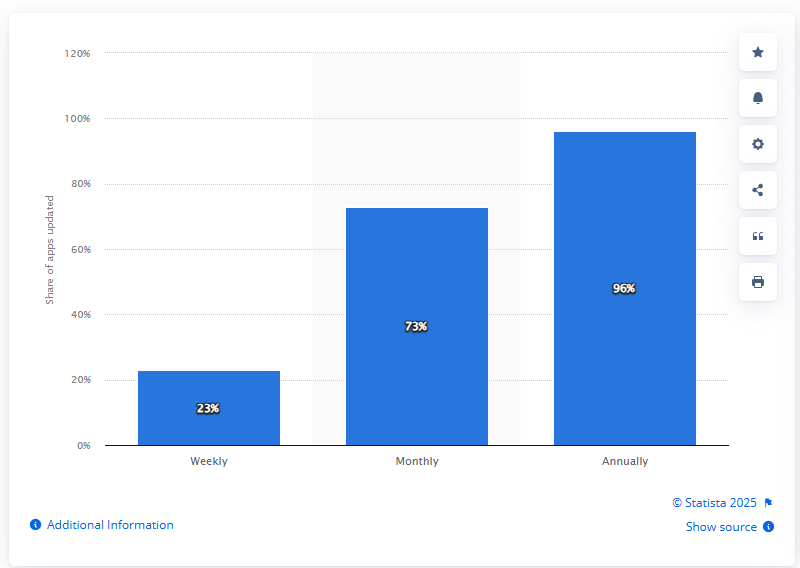
Here are some other fascinating stats about iOS app development, highlighting the availability of iOS applications in the industry:
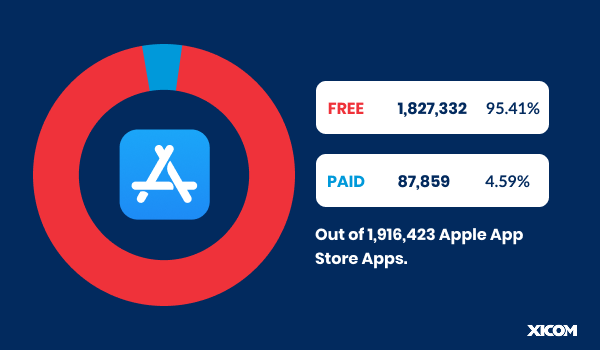
The increase in the popularity of Apple devices is increasing the opportunity for businesses to engage with a vast user base. So, by creating a customized iOS application for your business, you can witness higher reach. But how would you really map out the process to create an iOS application without knowing the exact iOS app development cost?
The article below covers all the details and considerations that contribute to the cost of the iOS app development process. With the right strategy and understanding of the development costs, you can create a high-functionality iOS application to transform your business and increase your digital presence without spending a fortune.
Even for an iOS app development company, stating the exact amount can be challenging. The cost to build an iOS app differs from one app to another, depending on several factors and requirements. The typical cost bracket for iOS app development ranges somewhere between $12,000- $50,000+.
To proceed with the calculation process for analyzing the approximate cost bracket, a business must evaluate numerous aspects to determine the overall development charges. The parameters to analyze the cost may include the app’s complexity, design needs, location of the developers, and integration of any third-party applications.
Here’s a quick formula you can use to calculate and analyze the total cost you would require to invest in developing an iOS application if you hire app developers:
Cost of developing an iOS app = Total number of development hours × Hourly developer rate
The above formula can only help you to analyze a rough figure of the cost you would really require to develop an ideal iOS application for your business. However, the exact cost again varies greatly depending on whether your application is a basic one or an advanced one.
Surely, cost is the major consideration for any business to build an iOS app, but apart from the cost, the development process encompasses various stages.
Creating an app that runs smoothly on the iOS ecosystem requires a systemic process with the below-mentioned stages:
To break down the iOS app development cost, let’s understand what factors majorly influence the cost bracket.
The cost of iOS app development is affected by several key factors. The most crucial factor that heavily impacts the cost of developing an iOS application is its complexity.
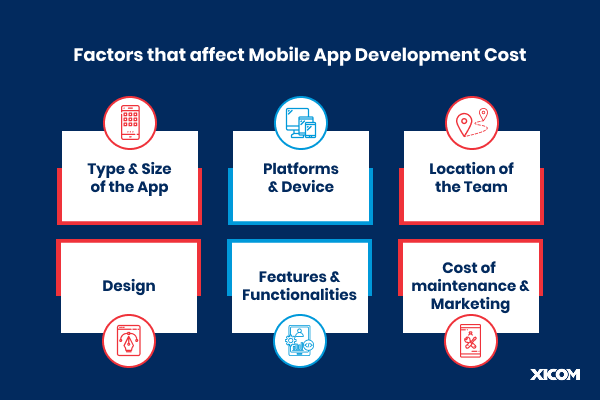
More complex apps require more integrations and development time, which further contribute to the developmental costs. Apart from complexity, another significant factor is the type of technology stack required and the specific features integrated within the application.
App design plays a big part in how users interact with it. Simple or complex, your app’s design should improve the user experience. Think carefully about how it adds value and appeals to your audience.
The cost to build an iOS app will depend on how complex it is. Simple apps are cheaper. But more features and extras raise costs. Think about how features add to complexity and costs. The goal is an app that gives value. It should fit your budget and goal.
Here’s the breakdown of the iPhone app development cost depending upon it’s complexity level to predict the iOS app development charges:
| App Complexity | Features | Cost Range | Approx Time Taken |
| Basic Size | Basic functionality (e.g., simple tools, utilities) | $12,000 to $15,000 | 2 to 4 months |
| Medium-Complex Apps | Standard user login, social media integration, and enhanced UI | $18,000 to $25,000 | 4 to 6 months |
| Advanced or Complex Apps | Advanced data processing, real-time interactions, and custom features | $25,000 to $50,000+ | 6 to 12 months |
App design plays a big part in how users interact with it. Simple or complex, your app’s design should improve the user experience. Think carefully about how it adds value and appeals to your audience.
A good design is about more than just making an app look attractive. It’s about giving users an intuitive experience that keeps them coming back. Simple or complex, the design and user experience are vital for an app’s success. They determine how enjoyable and user-friendly the app will be.
Below is the cost breakdown of the cost to build an iOS app based on the design:
| Design Complexity | Features Included | Cost Range |
| Basic Designs | Basic layout, user-friendly interface, standard design elements | $5,000 – $10,000+ |
| Custom Designs | Custom illustrations, complex animations, innovative navigation | $15,000 – $50,000+ |
The above numbers are an estimation of what cost you can assume to develop an iOS application. However, it will majorly vary depending on the type or requirements, the industry you are creating the app for, and the features you want to be built in.
Every industry has its unique requirements. Some require apps to facilitate their audiences with easy services like ubereats for food delivery or taxi booking apps for easy access to cab services meanwhile, others may require an interface to help users connect with others like social media apps. So, your business purpose defines your app category, creating demand for similar features. And integrations of required features directly increase the cost to build an iOS app.
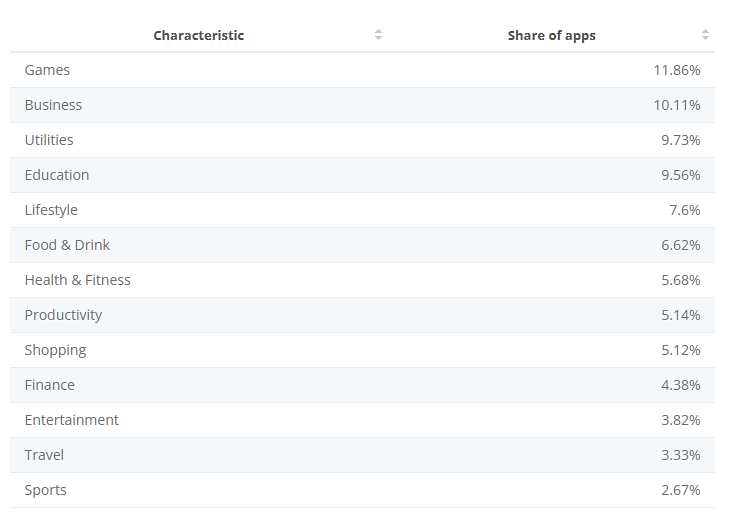
Source: Statista
Here are some of the major category types along with the estimated development cost:
The creation of Social Media apps involves push notifications, content sharing, integrating search functionalities and voice chats. All these features differ in complexity, social audio apps require authentication and real-time messaging, making it complex to develop. While on the other hand, profile creation and basic content sharing are relatively simpler to implement. The cost to create an iOS-friendly social media app can range from $40,000- $50,000 and even beyond. If thinking of integrating AI in social media apps then the estimated cost may rise above $50,000.
E-commerce apps are of higher complexity with intuitive search features and personalized recommendations powered by AI in E-commerce, shopping carts, secure payment gateways, and order tracking. The apps with features like smart reordering and 3D product imagining enhance user experiences. Additionally, the integrations of AI boost customized suggestions and dynamic pricing, crucial for Amazon- like Applications. The iOS app development cost for creating such e-commerce applications will be $50,000- $80,000+
Features like immersive graphics, multiplayer modes, in-game rewards, and AI-driven personalization for dynamic gameplay contribute to the cost to create a gaming app. For simple and basic 2D games, the cost required would be somewhere around $30,000- $80,000. And for high-end 3D games, a high development cost around $90,000- $100,000+ would be required.
From mental health apps to self-care apps, there is a range of healthcare applications available in the industry. The core applications of these healthcare apps include, telemedicine, virtual consultations, and remote patient monitoring for real-time health tracking. By leveraging machine learning development services, features like appointment scheduling, electronic health records (EHR) for centralizing patient data can be built. To integrate all these features within the healthcare app, the cost required will be $50,000- $60,000 and beyond, depending on the nature of the business.
Enterprise applications are the grade apps utilized for streamlining internal operations with reporting tools. These apps entail numerous features like enhanced security measures, custom app distributions, productivity tools, scalability, and increased user experience, which makes them complex. And the cost of iOS app development with higher complexity starts from $50,000 and can exceed depending upon the integrations.
Here’s an estimated cost breakdown of iOS applications according to their category type:
| Type | Description | Examples | Cost | Time |
| Social Media Apps | Features include push notifications, content sharing, user authentication, and real-time messaging | Instagram, Facebook | $40,000 – $50,000+ | 5-8 months |
| E-Commerce Apps | Includes shopping carts, secure payment gateways, AI-powered recommendations, and order tracking. | Amazon, eBay | $50,000 – $80,000+ | 3-8 months |
| Gaming Apps | Ranges from basic 2D games to high-end 3D games with immersive graphics, multiplayer modes, and AI-driven personalization. | Candy Crush (2D), Call of Duty (3D) | $30,000 – $100,000+ | 4-20 months |
| Healthcare Apps | Core functionalities include telemedicine, remote patient monitoring, appointment scheduling, and electronic health records (EHR). | MyChart, Teladoc Health | $50,000 – $60,000+ | 2-6 months |
| Enterprise Apps | Designed for internal operations with features like reporting tools, enhanced security measures, scalability, and productivity tools. | Slack, Microsoft Teams | $50,000 – $100,000+ | 2-10 months |
| Education Apps | Provides interactive learning tools like quizzes and video tutorials. May include AI for personalized learning experiences. | Duolingo, Khan Academy | $10,000 – $80,000 | 2-12 months |
| Travel Apps | Features include booking systems, geolocation services, and itinerary management. Integration with maps adds complexity. | Airbnb, TripAdvisor | $10,000 – $50,000 | 2-8 months |
| Shopping Apps | Focuses on product browsing and purchasing with secure payment integrations and user-friendly navigation. Similar to e-commerce but simpler in scope. | Wish | $10,000 – $50,000 | 3-8 months |
| Medical Apps | Specialized apps for doctors and patients with features like diagnostic tools and prescription management. | Epocrates | $30,000 – $90,000 | 2-6 months |
| Health & Fitness Apps | Tracks fitness metrics or health data using wearable integrations and analytics tools. | Fitbit | $10,000 – $250,000 | 1-15 months |
Undoubtedly, developing an iOS app isn’t a single-day task, it requires time and effort. All the designers, iOS app developers, and quality check team work together to bring out the ideal application aligning with the business requirements.
The time allotted by the developers increases the iOS app development cost. But rushing through these steps to reduce the cost will ultimately harm the quality of your applications. If you hire an iOS app developer, ensure to allow the required timelines to receive what you really planned for.
Here’s a cost breakdown based on the development time taken by different types of applications:
| App Size | Average Development Time | Average Cost |
| Small App | 2-4 months | $12,000-$15,000+ |
| Medium App | 4-8 months | $15,000-$25,000+ |
| Complex App | 9+ months | $25,000- $50,000+ |
The cost to build an iOS app differs throughout its development stages. Each stage incurs a different expense based on the resources, time, and complexity involved. With a clear understanding of these stages and the associated cost it becomes easier to create the right strategy within the budget.

The table below represents the charges to estimate on different stages of iOS app development, but the cost may vary according to the requirements of the app.
| Stage | Estimated Cost |
| Planning and Research | $5,000-$10,000 |
| UI/UX Design | $3,000-$6,000 |
| Frontend Development | $5,000-$10,000 |
| Backend Development | $10,000-$20,000 |
| QA and Testing | $1,000-$2,000 |
Creating iOS applications isn’t everyone’s cup of tea, and thus demand for skilled developers with fascinating mobile app ideas. Partnering with a team of developers has a major contribution towards the iPhone app development cost.
When the talk is about hiring developers for the iOS app development process, outsourcing the project to a development agency reduces the development cost, but where to outsource again becomes challenging. US-based app developers may charge $100 to $200 per hour, increasing the cost to build an iOS app.
However an iOS app development company in India will charge somewhere between $20-$40 per hour. So you see, there’s a huge difference between the charges, making it an ideal choice to outsource projects to developers in India.

Here’s a table representing the hourly charges of developers in different regions:
| Region | Hourly Rate (USD) |
| United States | $100-$150/hour |
| Ukraine | $35-$55/hour |
| Russia | $35-$60/hour |
| India | $20-$40/hour |
| Australia | $70 – $110/hour |
| Easter Europe | $50 – $100 |
The above table clearly shows that the price of iOS app development in India is the cheapest compared to anywhere else. If you desire to save money without any compromise on the app’s quality, then look forward to working with an app development company in India.
The process to build an iOS app is just like launching an e-commerce business. You want an amazing product, a smooth website, and a strong customer base. But just like a startup, you need to spend wisely and integrate the necessary features within the estimated budget, and for that, here are the steps:
With strategic planning, you can surely build an iOS application within estimated timelines, but some hidden costs can sneak up on you and blow your budget. So, it is more than important to understand the core areas imposing hidden charges and escalating your estimated iOS app development cost.
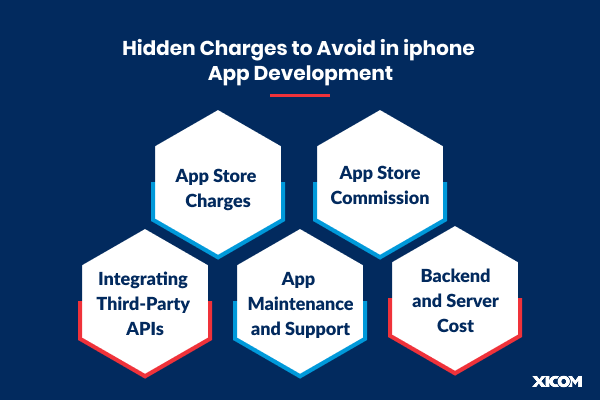
To develop and deploy your iOS application on the App Store, you must have an Apple Developer Program membership, which costs $99 annually. You must be aware that this is a recurring expense, not a one-time fee.
All the applications involving in-app purchases or subscriptions are required to pay commission to Apple:
To build external services like Google maps API or payment gateway like Bitpay, Firebase for Analytics requires additional costs. However, these services often have free trials, but only for limited users.
Annual updates are released by Apple and your app must adhere to those updates. So, timely updates are crucial to ensure your app remains compatible. Post-deployment maintenance ensures that fixes are fixed, and feature enhancements require ongoing development, requiring regular expense for developers.
Apps requiring database, authentication, or cloud storage require regular payment for
Android and iOS app development use different approaches for creating mobile applications. Each process requires its own set of tools, programming languages, design guidelines, and, most importantly, cost.
Let’s quickly differentiate both processes on certain parameters to identify the differences.
Over 2 decades, we have been tirelessly helping businesses by delivering their dream iOS applications. We build high-quality apps within estimated budgets by following a customized development approach and agile methodology. After understanding the business plan clearly, our skilled developers prioritize features while keeping the budget in mind to ensure cost efficiency without compromising quality and deliver an app that aligns with the business requirements.
Our experienced developers are well-equipped with latest technologies and Apple’s guidelines which contributes towards the smooth App store approvals and optimal performance. We not only develop mobile applications, we turn the dreams into reality to help businesses of all sizes. Connect with our consultants to plan your dream app on a budget.
At the ending of the blog, you would have now understood that determining the exact cost to build an iOS application depends on various factors like the app’s complexity, features, design, and third-party integrations. In order to build a high-functioning, feature-rich and scalable application without overspending, work on creating the right strategy with experts.
Developers at Xicom Technologies, a leading iOS app development company are highly skilled and talented having industry-wise experience in creating iOS apps. So irrespective of the industry you are working in, we can align the best developers to deliver your iOS application within an estimated budget. You can also connect with our experts to get a detailed cost breakdown for your project.
Refer to this additional information to plan out the right strategy for your iOS app while saving money:
iPhone application development cost is determined by a variety of factors, including app complexity, design, features included, development time taken, and the geographic location of the developers. Integrating extensive features like AI can increase the cost.
The cost to build an iOS app can range from $12,000 to $50,000+, depending on several factors. Simple apps with basic features cost less than advanced apps with sophisticated features.
Yes, typically an iOS can support multiple devices since most of the iOS apps are designed with special UI adjustments for different screen sizes of iPhone and iPads. For Apple Watches developers need to create a separate watchOS extension that pairs with the iPhone app.
In India, the cost of iOS app development typically ranges from $20-$40/ hour, depending on the developer’s experience and the complexity of the app.
The estimated cost to hire an iOS app developer can vary depending on their location and expertise. The estimated cost range is $20-$150 per hour.
You can check out the below-mentioned steps to hire an iOS app developer:
– Create a predefined plan to highlight specific project requirements like the functionality, features, and purpose of the app.
– Set a budget by analyzing how much you can invest in the development, including hourly rates and charges like app store fees.
– Decide whether you want to hire a freelancer, develop an in-house team, or outsource the project
– Evaluate essential technical skills and expertise in Swift, Objective-C, and Xcode.
– Check for their portfolios, past-client reviews, and ratings.
– Conduct interviews to assess communication, soft, and problem-solving skills.